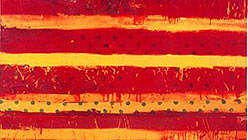While in New York, I was lucky enough to catch the last night of the Whitney Biennial. The unlucky part was seeing the exhibit and parts of the collection at an undesirably fast pace just before it closed, but it was still my best and most packed art-viewing excursion. On the outside of the building, big letters indicate that you are about to be faced with endless artwork as far as the eye can see. We started on the first floor and dropped some knowledge into a broadcasting microphone, part of Neighborhood Public Radio’s installation. NPR is a San Francisco artist collective with a motto that reads: “If it’s in the neighborhood and it makes noise .. we hope to put it on the air.” Other local favorites in the Biennial were Robert Bechtle‘s photorealistic paintings and Mitzi Peterson’s glitter-encrusted cement blocks. I felt proud of my town. We may not have as many high-profile exhibitions as NY, but we produce the art-world equivalent of rock stars.
Some of the freshest work in the Biennial was that of LA artist Ry Rocklen who works with found junk repurposed in his studio. Refuge was the skeleton of a mattress with nails painstakingly poked through each and every hole in its mesh covering. Blue Moon was a collection of silver-leaf, kitschy framed pictures you get at carnivals and tacky gift shops: images of kittens, rearing unicorns, rainbow hearts and such. The frames appeared to be in their original stand-up cardboard display, which was bent into a half-circle so you could walk into it and get a good look at the faded, manufactured wall art. The pictures looked uniform, the same not-so-shiny gleam and depressing blue hue. Sadly, these unwanted relics from an age of cheap overindulgence never fulfilled their destiny. It might seem like Rocklen did something simple, found an old thing and tossed it in a museum a la Duchamp, but removing a familiar object from its context invokes feelings, memories and reflection in a much different way than a completely original creation does.
Here is my laundry list of other Biennial gems: Oakland native Jedediah Caesar’s shipping container-sized block appearing as melted rainbow wax, but actually made of pigmented resin on polystyrene — a beautifully hideous masterpiece. Heather Rowe’s Entrance (for some sites in dispute) — a sculptural corridor made of plywood beams and shards of mirror — when you walked through it, your reflection would appear intermittently as you passed the mirror slivers, causing a feeling of fading invisible powers. And Mika Rottenberg’s large installation, a log cabin/chicken coop structure with several monitors playing her film, Cheese, featuring extremely long-haired women milking goats. The installation was crowded and though I wanted to see more, time was running out.
Oh, did you think I was finished? Not even. There’s still the Whitney’s collection and the exhibition of Robert Mapplethorpe Poloroids. Pardon my nerdy-ness, but when I’m in New York, it’s like seeing art history textbooks come alive. I’ve been known to gasp loudly when I find myself confronted with a piece of art I’ve only read about. This is what happened when I found myself in front of the late Robert Rauschenberg’s works (1925-2008, RIP), one of which I’d just read about in Jonathan Katz’s 13-page article, “Committing the Perfect Crime: Sexuality, Assemblage and the Postmodern Turn in American Art.” The piece in question was Yoicks, a large, mixed-media work of stripes and dots in green, yellow and red. Katz’s article mentioned the autobiographical nature of the heavily painted-over comics that were mixed into Rauschenberg’s works in the mid-50s and the fact that the stripes in Yoicks represented the dialogue in which he was engaging with his then-boyfriend and studio mate Jasper Johns. Johns was concurrently creating the stars and stripes of his well-known painting, Flag.
Next were three Claes Oldenburg beauties including a plate of fries with ketchup and a B.L.T. sewn out of soft vinyl and stuffed. They were accurately colored and pleasantly chunky. I flew past some Hoppers, Calders and other art history staples, and wound up in the Mapplethorpe exhibit of black-and-white Polaroids. Displayed for the first time were portraits of his friends: some known, some nude, and some anonymous. The immediacy of the medium and the relationship between photographer and subject conveyed vulnerability and hints of distinct moments in the artist’s life.


